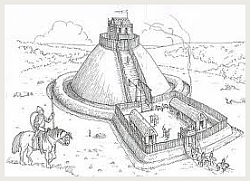Turbet Island & The Motte and Bailey
Kilconny, Belturbet, Co Cavan
The name Belturbet, comes from the gaelic words beal (mouth) and Tairbeart (isthmus or peninsula). Translated literally Belturbet is the mouth of the peninsula. Turbet Island, which is located beside kilconny bridge and has its own parking lot is the mouth of the peninsula.
Walking in Cavan
Today the island is a beautiful place to visit. It features a quiet, nature filled, fully accessible walking trail, along the river Erne, which runs from the parking lot at Kilconny bridge past the Anglo Norman remnants of the Motte and Bailey, on up to the Railway Bridge (a remnant of The Great Northern Railway) and either back again to the parking lot or on into town if you are following “The Belturbet Heritage Walking Trail” .
The first ever remnants in Europe of the prehistoric Wooly Mammoth were found on Turbet island! and are house in the natural History Museum in Dublin city. The island or the peninsula is probably the main reason why the town came into existence.
The History of the Motte and Bailey
To understand the significance of the Motte and Bailey, one has to think back to years before roads and highways, and before even railways, to a time when rivers where the main arteries of commerce. Most of the regions trade and commerce was conducted via the river, and because the River Erne was such a large river we can only imagine how important control of the river was.
Because of the peninsula in Belturbet, there was a shallow crossing point known as a ford here. This was the only point for miles around where the river could be forded or crossed and so Belturbet was very much so the “ford at the river”. Whoever controlled this ford would have been in a great position of power because if you controlled who could cross the river you controlled the trade on the river and you controlled the tariffs and taxes etc.
Belturbet was the Ford, and above the ford you had Clough Oughter Castle, and below it you had Crom Castle, Balfour Castle, and Enniskillen Castle. Because of the obvious strategic importance of Belturbet, the Anglo Normans built a Motte and Bailey on the island at some time in the 13th century and this represents the earliest known settlement of the town itself.

A Motte and Bailey is essentially a defensive fortification which was used by the Anglo Normans during their conquests in Ireland during the 13th century. The “motte” was an earthwork thrown up by digging a ditch around the outside. On the top you would have a timber made keep which would be protected and fortified and this would be used when under attack. Outside the Motte, and connected by a drawbridge, would be the bailey which was a fenced in compound used to protect stores and livestock’s, and for men under camp.
What is unusual about the motte and bailey in Belturbet is that there appears to be a double motte, as in there is one on either side of the bailey. This is unique to Cavan and other surrounding counties and perhaps indicates that the motte and bailey in Belturbet was fairly large and therefore very important.
There is evidence that at one point a stone tower was erected on the motte, but sadly one must use ones imagination to picture the scope of what such a settlement was in the thirteenth century. Much of the evidence of the settlement is all but gone, and until properly surveyed cannot really be reclaimed.
The Motte and Bailey in Belturbet is an extremely important place in terms of the history of the town and indeed the whole region socially, economically, and historically. The location is officially listed as one of The Marble Arch Geopark official sites.
Turbet island and the Motte and Bailey is a fantastic place to go for a walk, have a picnic, and get lost in the surroundings of peace and nature. It is easily accessible by car or by foot and all trails are fully accessible for wheelchairs and strollers etc.
Trail maps and tourist information are available from the Railway Station in Belturbet, Co Cavan. (Directions: take the street between Gala shop and Banquets to Bouquets florist and go straight down all the way until you get to the Stone Railway Masters Station House)
Visit Cavan Geopark for more sites of exceptional geological heritage





